
Kastamonu Province is one of the provinces of Turkey, in the Black Sea region to the north of the country. It is surrounded by Sinop to the east, Bartın, Karabük to the west, Çankırı to the south, Çorum to the southeast and the Black Sea to the north.
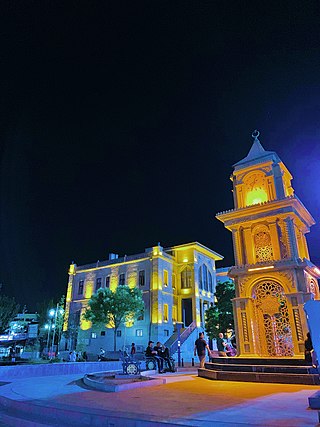
Aksaray Province is a province in central Turkey. Its adjacent provinces are Konya along the west and south, Niğde to the southeast, Nevşehir to the east, and Kırşehir to the north. It covers an area of 7,626 square kilometres (2,944 sq mi). The provincial capital is the city of Aksaray. Aksaray is one of the four provinces in the area of Cappadocia, along with Nevşehir, Niğde and Kayseri. Also the 3,000-metre (9,843 ft) volcano Mount Hasan stands between Aksaray and Niğde. Summers are hot and dry on the plain, but the area is green and covered in flowers in springtime, when water streams off the mountainside. The 2,400 m2 salt lake, Tuz Gölü, lies within the boundaries of Aksaray, a large area of swamp with a maximum depth of 1 metre.
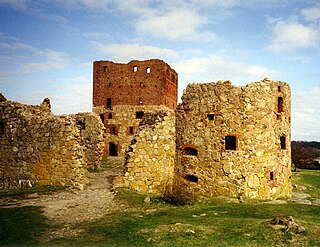
Hammershus is a medieval era fortification at Hammeren on the northern tip of the Danish island of Bornholm. The fortress was partially demolished around 1750 and is now a ruin. It was partially restored around 1900.

The Chobanids were the ruling dynasty of the Anatolian beylik that controlled the city and region of Kastamonu in the 13th century.

Qasr al-Hayr al-Gharbi is a Syrian desert castle or qasr located 80 km south-west of Palmyra on the Damascus road. The castle is a twin palace of Qasr al-Hayr al-Sharqi, built by the Umayyad caliph Hisham ibn Abd al-Malik in 727 CE. It was built in the Umayyad architectural style.
Karadere Dam is a dam in Kastamonu Province, Turkey, built between 1993 and 2007. The development was backed by the Turkish State Hydraulic Works. Karadere Dam is built for irrigation purposes and can be found between Kastamonu and Taşköprü. The scope of work includes 1,500,000 cubic metres (53,000,000 cu ft) of excavation and 3,000,000 m3 (110,000,000 cu ft) of fill. It has a 497-metre (1,631 ft) long diversion tunnel which is 3.5 metres (11 ft) in diameter.
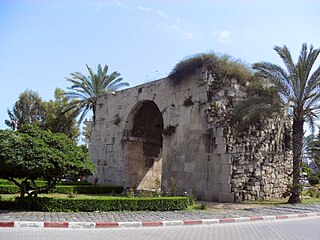
Cleopatra's Gate is a city gate of Tarsus, in Mersin Province, Turkey, named after the Egyptian (Ptolemaic) queen Cleopatra VII.

Meydancık Castle is a castle ruin in Mersin Province, Turkey. The original name was Kirshu and the name of the ruin during Ottoman times was Beydili Kale.
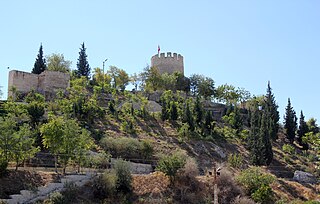
Mut Castle is a castle in Mut, Mersin Province, Turkey.

Ilgaz Mountains is a mountain range in northwest Anatolia, Turkey. It belongs to the Pontic Mountains system.
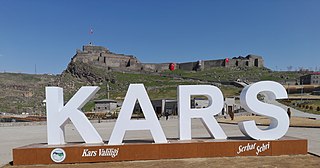
The Castle of Kars is a former fortification located in Kars, Turkey. It is also known under the name Iç Kale.

The Stone Bridge or Silifke Bridge is a historical bridge in Mersin Province, Turkey.

Tekfur ambarı is a large cistern in Silifke ( Seleukeia) ilçe district center of Mersin Province, Turkey. A part of the city of Silifke, it is situated to the west of city center and to the east of Silifke castle at 36°23′N33°55′E. It was built during the early years of Byzantine Empire. The building material is face stone. The west to east dimension is 46 metres (151 ft) and the north to south dimension is 23 metres (75 ft). The depth of the cistern is 14 metres (46 ft). The total water capacity is about 12 000 tonnes. At the east side of the cistern there is a spiral staircase. There are 8 niches at the 46 m dimension and 5 niches at the 23 m dimension.

The Cistern of Aspar or Great Cistern, known in Turkish as Sultan Selim Çukurbostanı, was a Byzantine open-air water reservoir in the city of Constantinople.

The Cistern of Mocius, known in Turkish as Altımermer Çukurbostanı, was the largest Byzantine open-sky water reservoir built in the city of Constantinople.
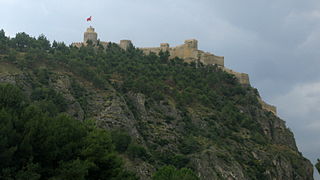
Boyabat Castle, is a castle in the town of Boyabat, Sinop Province, Turkey built by the Paphlagonians in antiquity and reconstructed under Roman, Byzantine, and Ottoman rule. The castle functions as a museum today.
Kastamonu Ethnography Museum is a museum in Kastamonu, Turkey

The Temple of Jupiter is a ruined Roman temple in Silifke, Turkey. It was built in the 2nd century, and presently one column still stands.
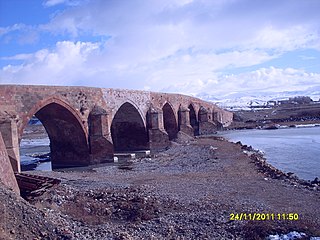
Çobandede Bridge is a historical bridge in Erzurum Province of Turkey.

Eğirdir Castle is a castle in Turkey.




















